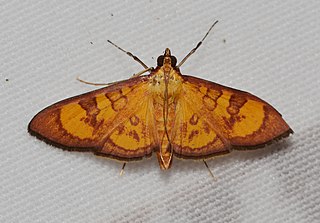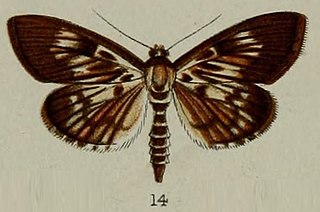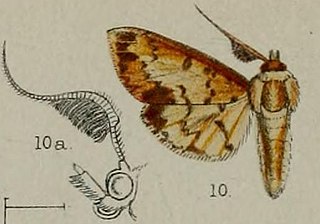
Prenesta is a genus of moths in the family Crambidae. The type species is Prenesta fabialis.

Spilosoma curvilinea is a species of moth of the family Erebidae. It was described by Francis Walker in 1855. It is found in Cameroon, Republic of the Congo, Democratic Republic of the Congo, Ghana, Ivory Coast, Kenya, Nigeria, Senegal, Sierra Leone, Sudan, Tanzania, the Gambia and Uganda.
Phostria albescentalis is a species of moth in the family Crambidae. It was described by George Hampson in 1918. It is found in the Democratic Republic of the Congo, Kenya and Mozambique.
Pilocrocis dichocrosialis is a species of moth in the family Crambidae. It was described by George Hampson in 1912. It is found in Cameroon, the Democratic Republic of the Congo (Katanga), Malawi, Mozambique, Zambia and Zimbabwe.
Pilocrocis pterygodia is a moth in the family Crambidae. It was described by George Hampson in 1912. It is found in Ghana, South Africa, Uganda and Zimbabwe.
Pilocrocis xanthostictalis is a moth in the family Crambidae. It was described by George Hampson in 1908. It is found in the Democratic Republic of the Congo, Madagascar and Tanzania.
Pycnarmon peruvialis is a moth in the family Crambidae. It was described by George Hampson in 1917 and it is found in Peru.
Pycnarmon aripanalis is a moth in the family Crambidae. It was described by George Hampson in 1899. It is found in Australia, where it has been recorded from Queensland.
Sufetula nigrescens is a moth in the family Crambidae. It was described by George Hampson in 1912. It is found in the Democratic Republic of the Congo, Ivory Coast, Madagascar, Nigeria and Sierra Leone.
Syllepte methyalinalis is a moth in the family Crambidae. It was described by George Hampson in 1912. It is found in Guyana.
Syllepte xylocraspis is a moth in the family Crambidae. It was described by George Hampson in 1912. It is found in South Africa.
Syllepte attenualis is a moth in the family Crambidae. It was described by George Hampson in 1912. It is endemic to Kenya.
Syllepte strigicincta is a moth in the family Crambidae. It was described by George Hampson in 1912. It is found in Ecuador.
Syllepte mesoleucalis is a moth in the family Crambidae. It was described by George Hampson in 1898. It is endemic to South Africa.
Syllepte orbiferalis is a moth in the family Crambidae. It was described by George Hampson in 1898. It is found on Réunion and in South Africa.

Syllepte picalis is a moth in the family Crambidae. It was described by George Hampson in 1898. It is found in Meghalaya, India.

Syllepte plumifera is a moth in the family Crambidae. It was described by George Hampson in 1898. It is found in Indonesia and Papua New Guinea, where it has been recorded from the D'Entrecasteaux Islands.
Syllepte purpurascens is a moth in the family Crambidae. It was described by George Hampson in 1899. It is found in the Democratic Republic of the Congo, Kenya, South Africa and Tanzania.
Syllepte melanopalis is a moth in the family Crambidae. It was described by George Hampson in 1908. It is endemic to Mayotte in the Indian Ocean off the coast of southeast Africa.
Ambia cymophoralis is a moth in the family Crambidae described by George Hampson in 1917. It is found on St Aignan Island in the Louisiade Archipelago of Papua New Guinea.



